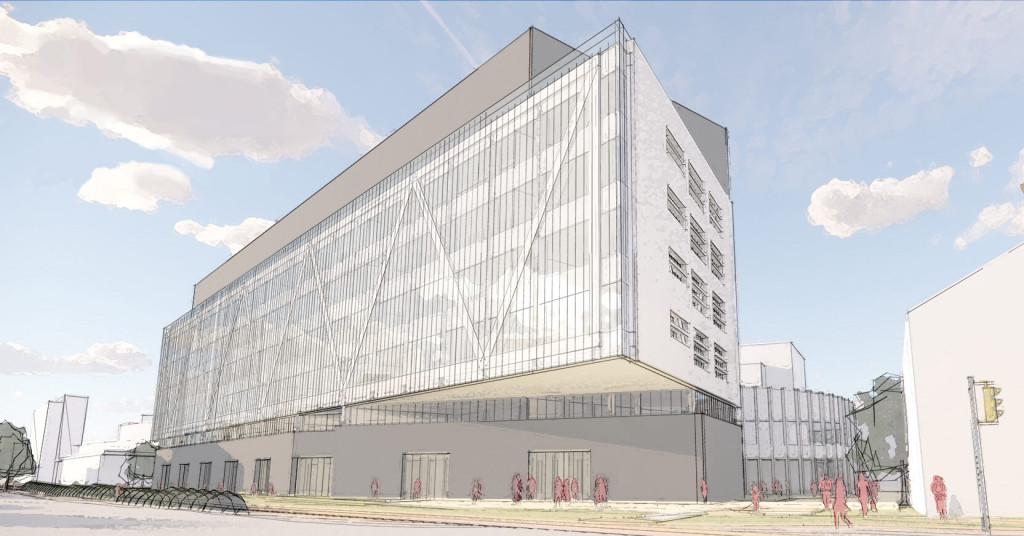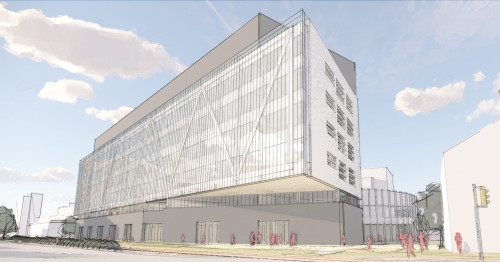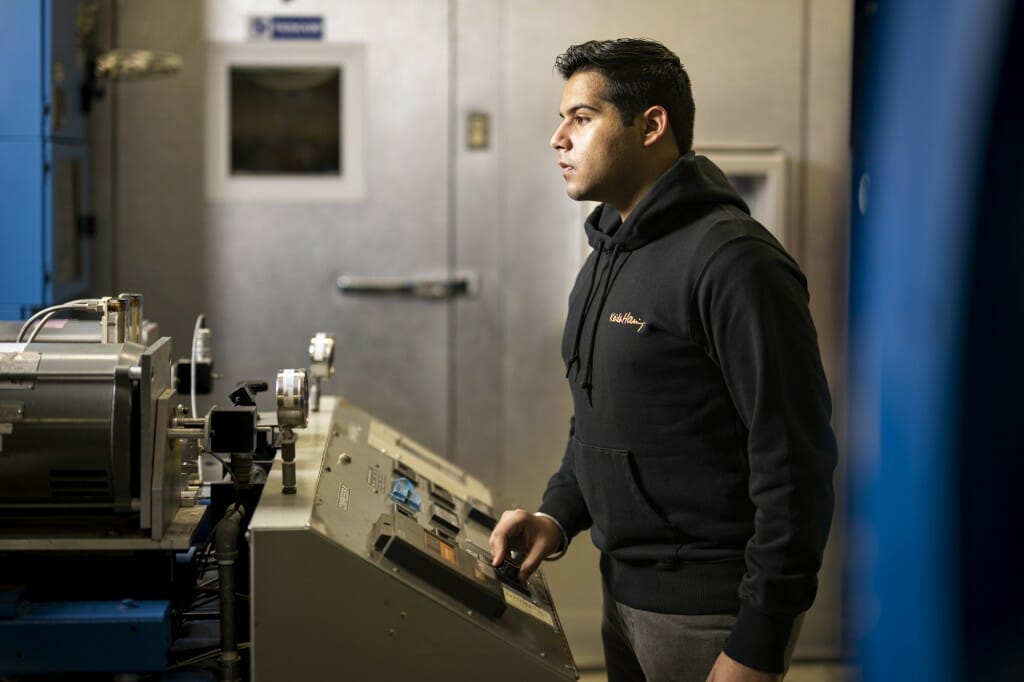UW–Madison engineering talent critical to state, national economic progress

A new 395,000 square foot facility that would replace the 64,000 square foot building at 1410 Engineering Drive would give the College of Engineering the modern space to educate many more students and position the College to stay competitive with its peers nationwide. Artist's rendition
Updated: May 25, 2023
Editor’s note: Across the state and the nation, demand for engineering graduates is high, but the UW–Madison College of Engineering has the capacity right now to accept fewer than 20% of the students who apply. With a proposed new building, the college could educate many more of the best and brightest students to help build Wisconsin’s future. Find out how you can help support this work.
Many of Wisconsin’s most notable companies have grown from family businesses founded decades ago into multibillion-dollar companies with an international reach — and engineers drive the innovations that underlie their progress, global competitiveness and economic success.
“Engineers are a multiplier in the workforce,” says Todd Kelsey (BSEE ’87, MSEE ’89), CEO of Plexus, a global company specializing in highly complex design, manufacturing, supply chain and aftermarket services based in Neenah, Wisconsin. “They create things, and by creating things, they create jobs. Engineering is critical to make our economy grow.”
Beyond manufactured goods, engineers also play a major role in virtually every aspect of our daily lives. They design our transportation systems, buildings, water supplies, and energy infrastructure. They enable all aspects of our digital infrastructure, from smartphones to advanced wireless networks to the cloud — and they create systems to keep our data secure. In healthcare, engineers pioneer solutions for diagnosing and treating disease or improving the way in which patients receive care. And they create new materials that enable progress in these applications, and countless others.
University of Wisconsin–Madison engineers are critical to all of these efforts, says Ian Robertson, Grainger Dean of the College of Engineering. “When you think of the grand challenges the state of Wisconsin, the nation, and our society are facing — clean energy, clean water, next-generation transportation, cybersecurity, healthcare and many more — our students and our faculty are working in all of those areas,” he says.
In the workforce, UW–Madison engineers make a big impact around the world — but also close to home: Each year, approximately 700 engineering bachelor’s degree recipients take positions with small, medium and large companies in the Midwest. And not only do they work in the region, a third (almost 17,000) of all UW–Madison engineering alumni reside in one of Wisconsin’s 72 counties.
The College of Engineering’s current annual enrollment is close to 6,000 total students, and each year approximately 1,500 students earn engineering degrees.
Yet, industry demand for engineers is outpacing the supply. “We can’t grow our company without continuing to innovate and develop new technologies, and we need more UW–Madison engineers coming in to help us do that,” says John Pfeifer, president and CEO of Oshkosh Corp.
“Every company I meet with in Wisconsin tells me, ‘We want more Badger engineers.’”
Ian Robertson
At any given time, approximately 20,000 internship, co-op and full-time engineering jobs are posted in Handshake, UW–Madison’s online career management system. Annually, 3,500 employers seek Badger engineers, and some 500 of those organizations recruit in person on the engineering campus. According to the U.S. Bureau of Labor Statistics, the engineering profession needs to grow by 15% to meet increasing demand and to replace retiring baby boomers.
“Every company I meet with in Wisconsin tells me, ‘We want more Badger engineers,’” says Robertson.
Not only do companies want more UW–Madison engineers, but they also prioritize recruiting at the university, says John Archambault, assistant dean for engineering student development and director of the Engineering Career Services office at UW–Madison. “Employers say we are at the top of their recruiting lists because of our national ranking and our reputation for high-quality students with demonstrated leadership skills and a strong work ethic,” he says. “They see these attributes not only in our graduates, but in our alumni already working in their organizations.”
 With a new building, the College of Engineering could educate many more of the best and brightest students to help build Wisconsin’s future.
With a new building, the College of Engineering could educate many more of the best and brightest students to help build Wisconsin’s future.
Archambault says the college’s rigorous curriculum helps students become innovative problem-solvers, while hands-on design and capstone courses allow them to apply their engineering training to real challenges. Additionally, more than 80% of students participate in one or more internships or co-operative work terms. “As a result, they already have on-the-job experience and are ready to step into a professional role,” he says.
Their depth of preparation also means that UW–Madison engineering bachelor’s degree recipients command starting salaries generally higher than the national average.
Admission to the College of Engineering is extremely competitive, says Robertson.
Each year, some 8,000 talented students apply to UW–Madison with a desire to become engineering undergraduates “Our college can admit only about 1,200,” he says. “That capacity is limited by the space and the facilities we have available, as well as the number of faculty and staff we have to educate our students.”
In contrast to UW–Madison’s overall undergraduate engineering enrollment of 4,500, competitor universities such as Purdue, Illinois, Penn State, Ohio State, Michigan State and Michigan have engineering undergraduate student body sizes ranging from 6,000 to nearly 9,500 students. Those engineering colleges also recently have dedicated new state-of-the-art “signature” engineering buildings.
With an ambitious plan to grow to 5,500 undergraduates and 2,000 graduate students, Robertson says the UW–Madison College of Engineering needs to follow suit. “We need to grow not only to meet student and employer demand, but also to remain attractive to them. If we want to continue to recruit the best talent — and that means at the faculty, staff and student level — we need facilities that are comparable to our peers,” he says.
A planned new building is a critical starting point in the college’s ability to provide a hands-on education to many more engineering students and help keep pace with industry growth. The $355 million building will be funded through $205 million in state and $150 million in gift support. It will provide the college much-needed space to accept additional students, recruit and retain top-tier faculty members to educate them, and to sustain its excellence in research and graduate education. Find out more.

The College of Engineering’s rigorous curriculum helps students become innovative problem-solvers, while hands-on design and capstone courses allow them to apply their engineering training to real challenges. Photo: Bryce Richter
Editor’s note: When it comes to helping Wisconsin residents and the state’s economy, you Can’t Stop a Badger. This spring, we’re highlighting the ways UW–Madison delivers tangible benefits for Wisconsinites and the world. Follow along using #CantStopABadger on social media.
Enjoy this story?
Read more news from the College of EngineeringSubscribe to Wisconsin Ideas
Want more stories of the Wisconsin Idea in action? Sign-up for our monthly e-newsletter highlighting how Badgers are taking their education and research beyond the boundaries of the classroom to improve lives.
